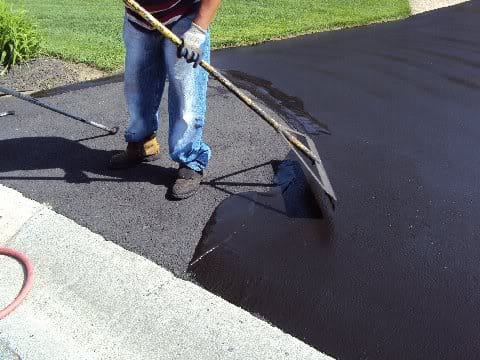Hot Mix Asphalt: A Lasting Service for Pavement
Warm Mix Asphalt (HMA) has actually emerged as a leading lasting option for sidewalk solutions, providing a myriad of innovative innovations and environmental advantages. As the demand for green construction techniques grows, checking out the subtleties of HMA's sustainability can give useful understandings right into the future of sidewalk services.
Ecological Advantages of Warm Mix Asphalt

Additionally, Warm Mix Asphalt aids to reduce city warm island effects. Its dark color takes in sunshine, decreasing the amount of heat mirrored back into the atmosphere compared to lighter-colored sidewalks. This can decrease ambient temperature levels in city areas, lowering the demand for air conditioning and eventually minimizing energy usage.
In addition, Hot Mix Asphalt adds to improved stormwater monitoring. Its porous nature allows water to charge and penetrate the pavement groundwater materials, decreasing overflow and the risk of flooding. These environmental benefits make Warm Mix Asphalt a lasting choice for paving roadways and highways.
Power Performance in HMA Manufacturing
Is energy efficiency an essential variable in the manufacturing of Hot Mix Asphalt (HMA)? Power plays a significant duty in the production of HMA, impacting both price and ecological sustainability. One vital element of power effectiveness in HMA production is the use of warm mix asphalt (WMA) modern technologies.
Moreover, advancements in plant modern technologies have brought about even more energy-efficient HMA manufacturing processes. Modern plants are developed with functions like recycled asphalt sidewalk (RAP) handling capacities, effective burner systems, and boosted insulation, all contributing to energy savings. By optimizing energy use in HMA production, the industry can lower its carbon footprint while preserving high-quality sidewalk materials. Power performance is, as a result, an important consideration in making sure the sustainability of Warm Mix Asphalt manufacturing.
Recyclability of Warm Mix Asphalt
The recyclability of Warm Mix Asphalt (HMA) is an essential aspect of its sustainability and long-term ecological impact. HMA is just one of the most recycled materials in the USA, with over 100 million lots of recovered asphalt pavement (RAP) being recycled each year in new pavement building. Recycling HMA provides a number of ecological advantages, such as decreasing the requirement for virgin products, reducing power consumption during manufacturing, and reducing the amount of waste article sent out to land fills.
The procedure of recycling HMA includes grating the existing sidewalk, squashing it into smaller pieces, and blending it with new aggregate and asphalt binder to develop a recycled mix. This recycled mix can typically execute as well as or perhaps better than conventional HMA, while requiring less raw products and creating lower greenhouse gas exhausts. By incorporating RAP into new pavement tasks, roadway firms can go to this web-site preserve natural deposits, reduce prices, and minimize the environmental impact of road construction and maintenance tasks. Overall, the recyclability of HMA plays a significant duty in promoting lasting methods within the sidewalk industry.

Long-Term Efficiency of HMA
Asphalt pavements show longevity and strength over an extended period, mirroring the long-term efficiency of Warm Mix Asphalt (HMA) Furthermore, advancements in HMA technology, such as the use of polymer-modified binders and cozy mix asphalt, have even more boosted the toughness and longevity of HMA sidewalks. By focusing on quality building and construction and maintenance methods, HMA continues to confirm itself as a lasting and cost-effective option for resilient sidewalk framework.
.png)
HMA: Resilience and Sustainability
Demonstrating both toughness and sustainability, Hot Mix Asphalt (HMA) has come to be a cornerstone in the construction of long-lasting pavement infrastructures - angled parking. HMA's resilience comes from its ability to hold up against heavy tons, severe weather, and high website traffic volumes, making it a reputable choice for streets, freeways, and airport terminal paths. The composition of HMA, which normally consists of aggregates, binder, and filler, plays a crucial function in improving its long life and resistance to tear and use
In addition, HMA's sustainability hinges on its recyclability and energy-efficient manufacturing procedure. The ability to reuse recovered asphalt pavement (RAP) in brand-new HMA mixtures minimizes the demand for virgin products and reduces the environmental impact of sidewalk building and construction and maintenance. Additionally, the energy performance of generating HMA hinges on its lower mixing temperature levels compared to various other pavement materials, bring about reduced energy usage and greenhouse gas discharges.
Verdict
To conclude, hot mix asphalt (HMA) uses a sustainable solution for pavement with its eco-friendly characteristics. HMA's recyclability, energy effectiveness in production, and long-lasting durability make it an environment-friendly selection for road building and construction. By preserving natural deposits, reducing waste, and decreasing greenhouse gas discharges, HMA plays an essential duty in advertising sustainability in facilities development. Its ability to alleviate metropolitan warmth island effects better underscores its significance in developing resilient and eco mindful pavement systems.
HMA is one of the most recycled products in the United States, with over 100 million tons of reclaimed asphalt pavement (RAP) being reused yearly in new sidewalk construction.The procedure of recycling HMA entails milling the existing sidewalk, squashing it right into smaller items, and mixing it with new aggregate and asphalt binder to produce a recycled mix.Asphalt pavements show resilience special info and strength over an extensive duration, mirroring the long-lasting efficiency of Warm Mix Asphalt (HMA) Furthermore, innovations in HMA modern technology, such as the usage of polymer-modified binders and cozy mix asphalt, have even more improved the longevity and longevity of HMA pavements. The capability to reuse recovered asphalt pavement (RAP) in new HMA mixtures decreases the demand for virgin products and lessens the environmental effect of pavement construction and maintenance.